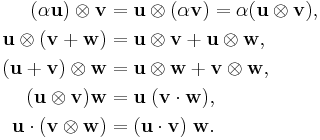Dyadic product
In mathematics, in particular multilinear algebra, the dyadic product
of two vectors,  and
and  , each having the same dimension, is the tensor product of the vectors and results in a tensor of order two and rank one. It is also called outer product.
, each having the same dimension, is the tensor product of the vectors and results in a tensor of order two and rank one. It is also called outer product.
Contents |
Components
With respect to a chosen basis  , the components
, the components  of the dyadic product
of the dyadic product  may be defined by
may be defined by
 ,
,
where
 ,
, ,
,
and
 .
.
Matrix representation
The dyadic product can be simply represented as the square matrix obtained by multiplying  as a column vector by
as a column vector by  as a row vector. For example,
as a row vector. For example,
where the arrow indicates that this is only one particular representation of the dyadic product, referring to a particular basis. In this representation, the dyadic product is a special case of the Kronecker product.
Identities
The following identities are a direct consequence of the definition of the dyadic product[1]:
See also
Notes
- ^ See Spencer (1992), page 19.
References
- A.J.M. Spencer (1992). Continuum Mechanics. Dover Publications. ISBN 0486435946..

